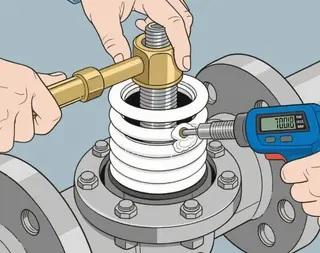How to Determine If Valve Packing Needs Replacement
In industrial production, valves are critical components for controlling fluid flow, and the packing gland is central to valve sealing. When the packing fails, media leakage may occur—compromising production efficiency, creating safety hazards, and even causing environmental issues. Timely assessment and replacement of valve packing are therefore essential for maintaining safe and reliable operation.
This article explains how to determine when valve packing needs replacement, outlining key inspection methods, warning signs, and replacement precautions.
1. Visual Inspection of Leakage
The most direct method is to check for visible leakage around the packing gland.
-
Liquid media: Look for seepage, droplets, or continuous fluid leakage along the valve stem.
-
Gaseous media: Apply soapy water to the suspected area—bubble formation indicates leakage.
-
Early-stage leakage: Slight dampness or minor droplets may not immediately impact valve function but should be closely monitored.
-
Severe leakage: Continuous liquid flow or substantial gas escape requires immediate replacement to avoid safety risks or process failures.
2. Sensation During Valve Operation
Abnormal resistance when operating the valve can signal packing issues:
-
Increased torque/force: A handwheel or actuator that previously moved smoothly may require much more effort due to hardened, compacted, or dried packing.
-
Uneven stem movement: Sticking, jerking, or shaking of the stem may result from uneven friction caused by packing wear, partial damage, or poor installation.
3. Inspection of Packing Condition
During scheduled maintenance, open the packing gland (if possible) to check packing condition:
-
Appearance: Signs of hardening, brittleness, discoloration (e.g., graphite turning gray-white from chemical erosion) indicate aging.
-
Wear: Noticeably reduced thickness, loose structure, or broken fibers mean the packing can no longer provide adequate sealing force.
-
Elasticity: Press the packing—if it does not rebound, elasticity has been lost, reducing its sealing effectiveness.
4. Review of Maintenance Records and Service Life
Maintenance history and operating environment provide valuable clues:
-
Repeated repairs: If leakage persists despite tightening or adding packing, replacement is necessary.
-
Service life estimates:
-
High-frequency, corrosive service (e.g., chemical plants) → replacement may be needed within 1 year.
-
Less demanding systems (e.g., water supply/drainage) → longer service life possible.
-
-
Long-term usage: Valves in operation for years should have packing replaced proactively once leakage or operational issues appear.
5. Additional Inspection Methods
Other practical checks include:
-
Residue inspection: Look for seepage marks or media deposits around the valve stem.
-
Touch test: Hardened, brittle, or rough packing indicates deterioration.
-
Paper test: Place clean paper near the gland—any wetting indicates leakage.
-
Pressure test: Poor sealing performance under pressure strongly suggests worn or aged packing.
6. Precautions for Replacing Valve Packing
When replacement is required, follow these best practices to ensure reliable sealing:
-
Shut down and drain system – Close the valve and fully discharge media before replacement.
-
Careful removal – Use proper tools (e.g., packing hooks) to extract old packing without scratching the stem or stuffing box. Hardened packing may be softened with suitable solvents.
-
Clean and lubricate – Thoroughly clean the stem surface and stuffing box, then apply graphite powder or suitable grease to reduce friction.
-
Select correct material – Choose packing based on service conditions:
-
Graphite → High temperature, pressure, corrosive media.
-
PTFE → Low friction, suitable for mild corrosion and lower temperatures.
-
Flexible graphite composites → Balanced performance across harsh conditions.
-
-
Proper installation – Install rings sequentially, staggering joints to avoid leakage paths. Tighten gland bolts evenly—avoid overtightening (which damages the stem) or undertightening (which causes leakage).
Conclusion
Determining when valve packing requires replacement involves a combination of visual inspection, operational checks, material assessment, and service history review. By promptly identifying leakage, wear, or loss of elasticity, operators can prevent failures, improve safety, and extend valve life.
When replacement is necessary, selecting the correct packing material, preparing the valve properly, and following correct installation procedures are critical for restoring sealing performance. With proper inspection and maintenance, valve packing can ensure long-term reliability and safe industrial operation.
It's important to know about Google SEO to help your website rank higher in search results.

